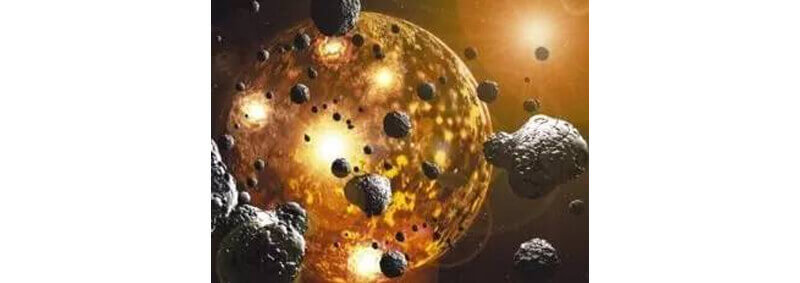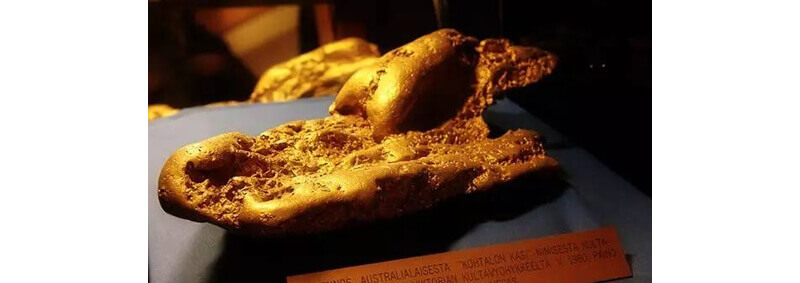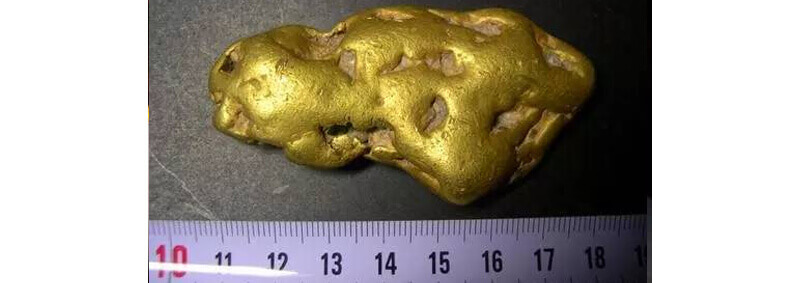Everyone likes gold, but do you know how gold is formed? How does gold in nature exist? Let’s learn about the Geology of native gold!
1. At 4.5 billion years ago, the Earth was formed as a large fireball with a high temperature enough to melt most minerals. Many small celestial bodies in the universe carry some metal elements (including gold). When the celestial body hits the earth, the meteorite is melted, and the gold remains. Because of the high density of gold, gold sinks into the earth, so now gold mining action is all underground.
2. According to scientists’ measurements and estimates, the Earth’s total gold reserves are about 4.8 billion tons, while about 4.7 billion tons are distributed in the core, and the mantle is 86 million tons, while the distribution to the earth’s crust is less than 100 million tons.
More than 99% of the gold on the earth enters the core. This distribution of gold is formed during the long-term evolution of the Earth.
The earth’s crust formed in the early stage of the earth’s development has a high abundance of gold. Therefore, it can represent the Archean greenstone belt composed of the early residual crust, especially the combination of mafic and ultramafic volcanic rocks, which may become the earliest gold deposits.
You may interest in
Top 10 Gold Mines in the World 2019
World Top 10 Gold Mining Companies List 2019
Gold mining equipment for sale
3. The gold treasures on the earth are mainly buried in the form of rock gold and sand gold. In addition, associated gold.
After Celestial bodies movement, earth formation, volcanic eruptions, ancient mountain movements, magma spurts, and gold elements are entrained from the core, the rock gold is formed.
The mountains were rich in gold form the alluvial gold during the process of sunshine weathering, thunder and lightning, violent storms, landslides, mudslides, flooding, and sedimentation in stable waters.
That is, the primary gold mine undergoes weathering and geological action, is broken and transported by flowing water to a suitable place to form the alluvial mine (placer gold).
4. According to scientific measurements and inferences, about 2.6 billion years ago in the Archean, volcanic eruptions brought a large amount of gold elements from the core to the mantle and the crust along the fissures, followed by ocean deposition and regional metamorphism. The role of the formation of the original gold source. About 100 million years ago in the Mesozoic, due to the powerful role, the crustal deformation pleats, pleats exposed to the sea surface, gold material activation migration and accumulation, forming a gold ore field, that is, what we call Rock gold.
5. Natural gold is a kind of mineral formed in hydrothermal geological action. The natural gold deposit of natural gold is collectively called rock gold or vein gold. The primary gold deposits are irregularly distributed in the formation formed by hydrothermal geology. In the gold-bearing quartz vein, gold can coexist with minerals such as pyrite, arsenopyrite, galena and sphalerite.
6. In the rock-rich enrichment zone, after the rock is oxidized, many natural gold and superficial layers of rock gold are often left. After tens of millions of years of weathering and denudation, the rock becomes sand. Because of the stable nature of gold, it is dissociated into monomers, in the process of river water transportation, because of their heavier density, they are deposited in the stable water of the river, thus forming a sand gold mine. So far, the largest gold nugget discovered by humans weighs 280 kg, which is produced in California, United States.
7. The gold deposits formed during the change of nature can be roughly divided into three categories: rock gold deposits, sand gold deposits and associated deposits. In the world, the ratio of reserves of rock gold, associated gold and sand gold is about 70:15:15. Among them, the rock gold deposit can be divided into several genetic types: magmatic-hydrothermal type, metamorphic hydrothermal type, volcanic hydrothermal type, sedimentary metamorphism type, hot water leaching type and metamorphic conglomerate type.
8. The proportion of various types of gold deposits in the world’s total reserves is 56.2% of metamorphic conglomerate type, 12.4% of metamorphic hydrothermal type, 9.5% of associated gold, 8.9% of sand gold, magmatic-hydrothermal type and volcanic heat. The liquid type is 7.0%, and the hot water leaching type is 0.9%.
9. Globally, according to the geotectonic units produced by gold mines, they can be divided into four categories: ground shield metallogenic areas, platform and marginal metallogenic areas, geosyncline fold belt metallogenic areas and the Pacific Rim metallogenic belt. Among them, the gold reserves produced by the shields accounted for 25.6–27.8% of the world’s total reserves; the local Mesozoic activation zones of the ancient platform caprocks accounted for 1.1–1.3%, and the excellent ground trough areas accounted for 12.9-15.6%; The area of the ground trough, accounting for 1.1–1.2%; and the area of the ancient platform cover, accounting for 47.1–47.7%.
LATEST PRODUCTS
Twin Screw Feeder
【Feeding Capacity】 10-160 t/h【Power】 2.2-…
Tubular Screw Conveyor
【Capacity】6-50 m3/h【Procesible Material】 …
Heavy Plate Feeder
Capacity: 100-240 m3/h Power: 15-45 kW Speed: 0…














